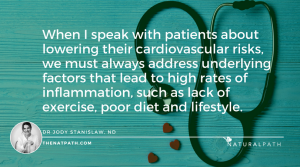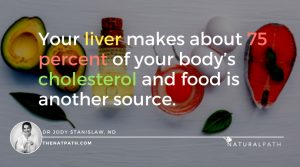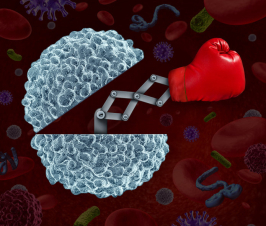Although total cholesterol has long been used as a key predictor of cardiovascular risk, research has proven that it’s actually a very poor indicator. There is a hyper-focus today on lowering total cholesterol to reduce the risk of heart disease but by doing so, we can actually cause more harm than good. There are healthier areas we should be focusing on to predict cardiovascular risk.
The role of cholesterol in your body
 First, let’s take a look at cholesterol and its role in your body. Cholesterol is a waxy substance that is not only found in your bloodstream but also in every cell of your body. Cholesterol is needed to help produce cell membranes, hormones, vitamin D, and bile acids that help digest fat. It also helps in the formation of your memories and is vital for healthy neurological function.
First, let’s take a look at cholesterol and its role in your body. Cholesterol is a waxy substance that is not only found in your bloodstream but also in every cell of your body. Cholesterol is needed to help produce cell membranes, hormones, vitamin D, and bile acids that help digest fat. It also helps in the formation of your memories and is vital for healthy neurological function.
Your liver makes about 75 percent of your body’s cholesterol and food is another source.
There are 2 main types:
- HDL is known as “good cholesterol” because it picks up cholesterol and takes it back to the liver for disposal.
- LDL carries cholesterol to the parts of your body that need it. It’s referred to as “bad cholesterol” because if you have too much of it in your bloodstream, it can cling to the walls of your arteries, causing dangerous plaque build-up. LDL cholesterol can also be found in foods containing trans fats. Trans fats are found in commercially prepared, processed foods containing partially hydrogenated oils and shortening.
Unfortunately, most cardiovascular risk assessments stop when only looking at total cholesterol but doing so gives an inaccurate picture of your true risk of cardiovascular disease.
People with total cholesterol levels over 250 can have a low heart disease risk if they have high HDL levels. Conversely, people with cholesterol levels under 200 can be found to have a very high risk of heart disease based on the following additional tests:
- HDL/Cholesterol ratio
- Triglyceride/HDL ratios
 HDL percentage is a very potent heart disease risk factor. Divide your HDL level by your cholesterol. That percentage should ideally be above 24 percent. You can also do the same with your triglycerides and HDL ratio. That percentage should be below 2. Keep in mind, however, that these are still simply guidelines, and there is a lot more that goes into your risk of heart disease than any one of these numbers.
HDL percentage is a very potent heart disease risk factor. Divide your HDL level by your cholesterol. That percentage should ideally be above 24 percent. You can also do the same with your triglycerides and HDL ratio. That percentage should be below 2. Keep in mind, however, that these are still simply guidelines, and there is a lot more that goes into your risk of heart disease than any one of these numbers.
The following additional tests have been shown to be more predictive of cardiovascular risk than total cholesterol.
At your next doctor’s appointment, discuss with your doctor the following tests:
- Lipoprotein(a): If levels are elevated, this is a very strong risk factor for heart disease.
- Triglycerides (TGs): Elevated levels of this dangerous fat have a clear link to heart disease and type 2 diabetes. TG levels can rise from eating too many grains and sugars, being physically inactive, smoking, drinking alcohol in excess and being overweight.
- LDL-P (particle number): Recent studies have looked into the importance of LDL-particle size. Studies show that people whose LDL particles are predominantly small and dense have a threefold greater risk of coronary heart disease. Furthermore, the large and fluffy type of LDL may be protective. However, it is possible that the association between small LDL and heart disease reflects an increased number of LDL particles in patients with small particles. Therefore, the number of LDL particles could be more significant in terms of risk than particle size itself.
- Apolipoprotein B: Apo B is a protein that is involved in the metabolism of lipids and is the main protein constituent of lipoproteins such as LDL and very low-density lipoprotein (VLDL).
- Hemoglobin A1c: Measures your average blood sugar level over the previous 3 months.
- Inflammation markers: Two key markers are hsCRP and Myeloperoxidase.
- Tumor Necrosis Factor alpha: TNF-alpha is a cell signaling protein involved in systemic inflammation.
- Free T3: A low level correlates with higher cardiovascular risk.
For further determination, if further cardiovascular tests are applicable to you, must be determined by a discussion with your primary doctor, or cardiologist, given your individual characteristics and risk factors.
These tests could include:
- Treadmill stress test
- Coronary artery calcium score
- Calcium density study
- CT angiography of the coronary arteries – checks degree of blockage
If you have high cholesterol, taking a cholesterol-lowering drug is often the first and only advice given at a doctor’s office. Yet many patients will experience unwanted side effects such as muscle pain, memory loss, liver damage, increased risk of diabetes and more.
When I speak with patients about lowering their cardiovascular risks, we must always address underlying factors that lead to high rates of inflammation, such as lack of exercise, poor diet and lifestyle.
From there, specific lifestyle choices, foods and vitamins can also help, such as those listed below.
12 natural ways to lower your risk of heart disease
- Exercise: Exercise is one of the few ways to not only lower your bad cholesterol (LDL), but also raise your good cholesterol (HDL).
- Eat Less Sugar: Sugar converts to fat in the body and is the guilty culprit to not only LDL cholesterol, but many other harmful effects to your overall health. Watch my TEDx talk: Sugar is Not a Treat to learn more about how sugar impacts your body.
- Eat more vegetables: Vegetables are rich in important vitamins, minerals, antioxidants and fiber. Fiber binds unwanted cholesterol and releases it from your body via your stool.
- Avocados: One avocado per week has been shown to reduce LDL cholesterol. Avocados are a good source of monounsaturated fats and high in omega-3 fats which can help improve the good HDL cholesterol your body produces.
- Fish oil or omega-3 fatty acids: These are natural anti-inflammatory nutrients that benefits your cardiovascular system. Every cell wall in your body is made of fat. When this wall contains a high concentration of omega-3 fats, the cell functions better overall. (Make sure the fish oil is from a high-quality brand because cheap fish oil can be toxic. 1000 mg of omega 3’s is the minimum daily dose.)
- Psyllium husk powder: This is high in fiber and can be taken in addition to eating more vegetables. When taken before meals, it can help you feel full sooner, thus eating less and losing weight.
- Garlic: You can eat it regularly with meals or find a supplement that contains 4000 mcg of allicin (the active ingredient in garlic) per day.
- Green tea: At least one cup per day has been shown to reduce cholesterol.
- Turmeric: This spice has been shown to reduce cholesterol and is also an excellent natural anti-inflammatory.
- Coenzyme Q10 supplement: CoQ10 is a key nutrient for optimal functioning of your heart. Cholesterol-lowering drugs (statins) lower levels of CoQ10 in the body and many people today are deficient, even without taking a statin.
- Antioxidants: Make a habit of keeping antioxidant-rich natural foods on hand, such as blueberries. Eat ½ cup of blueberries a day and/or take a supplement such as resveratrol.
- Quality Sleep: Sleep is essential for healing the body, balancing blood sugar, clearing the mind and maintaining overall health.
How to achieve optimal cardiovascular health
Regular exercise paired with a healthy, wholesome diet and lifestyle are your most powerful tools for achieving optimal cardiovascular health, as well as reducing the risk of today’s most common diseases. Taking a few, small, simple steps towards improving your diet and lifestyle can lead to big reductions in your cardiovascular risk. Implement 2 or 3 of the items from the list above today. Your heart will thank you.
Image Copyright: <a href=’https://www.123rf.com/profile_ezthaiphoto’>ezthaiphoto / 123RF Stock Photo</a>
 About Jody Stanislaw, ND, CDE: Dr. Jody Stanislaw received her doctorate degree in Naturopathic Medicine from the acclaimed holistic medical school, Bastyr University, in Seattle, WA. She is a Certified Diabetes Educator, Type 1 Diabetes Specialist and a founding board member of the Low Carb Diabetes Association. Having lived with type 1 diabetes since the age of 7, she has dedicated her career to helping others with type 1. From her 30+ years of experience, she teaches life-changing information about living well with type 1 diabetes that most patients and physicians have never learned.
About Jody Stanislaw, ND, CDE: Dr. Jody Stanislaw received her doctorate degree in Naturopathic Medicine from the acclaimed holistic medical school, Bastyr University, in Seattle, WA. She is a Certified Diabetes Educator, Type 1 Diabetes Specialist and a founding board member of the Low Carb Diabetes Association. Having lived with type 1 diabetes since the age of 7, she has dedicated her career to helping others with type 1. From her 30+ years of experience, she teaches life-changing information about living well with type 1 diabetes that most patients and physicians have never learned.

















